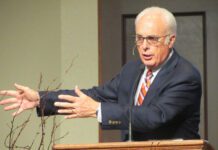2.) In the missional context: Preaching always demands a response. In other words, it is not the passive digesting of information through taking notes from which we go out and try to improve our personal Christian living. Preaching is the proclamation of God’s Story into and over our lives and inviting people into it. So there must necessarily be a response at the end of the sermon. Such a response should be here and now, after the hearing, that requires—by the Holy Spirit—a commitment to obedience, an act of submission, a confession of sin, an affirmation of God’s truth in my life, a profound act of gratitude that owns our participation in God’s grace. These moments shape the believer profoundly for life in Christ and His Mission. The congregation cannot sit passively gazing at the speaker—disconnected from him/her—taking notes to be applied at a later time. For this makes the gospel something we do, not who we become (from whence it becomes something we do!). Preaching turns from a transformational encounter into an impersonal information distribution to thousands of individuals who then go home and try to do something with what they’ve heard. The latter rarely happens.
At LOV, the response at the end of preaching often takes the form of a verbal response-prayer prayed by individuals in the congregation and responsively agreed with by the whole congregation in saying ‘Amen.’ It is intense and personal, yet congregational. It has become a highlight of our communal time together.
3.) In the missional context: Preaching is always better when we know the person—when he/she is one of us. Missional disciples are formed via modeling the life in following Christ. Often this modeling begins by the pastors themselves modeling when they preach out of their relationship with God in mission. This preaching will always be more effective out of authentic relationship—the being known by the congregation. In a congregation of 200, even if the actual person does not know the pastor preaching that day, he/she probably knows someone that actually does. The pastor is a real person. And the pastor, among the people, knows people and can preach the Word of God over their particular situation as one of them. The power of witness, a life lived in glaring humility and authenticity, ‘that very presence” (the Holy Spirit fills in order to) communicates the gospel. This is quite different phenomenologically from the preaching that happens via an image (a talking head) on a screen. The first one is preaching life among us, the second is a command performance often hiding the warts and problems of everyday life. For discipleship reasons, missional preaching is most effective when the pastor is known by the congregation.
Have I missed something here? Is there actually something missional about video-venue services? If so, what would that be? I invite “push back.”












